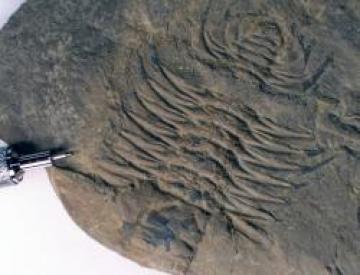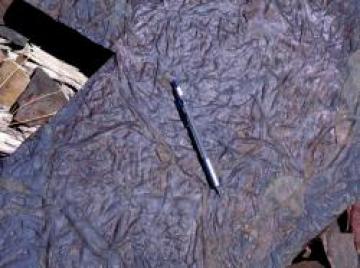The nature of fossil preservation
Sometimes the fossilized organism was buried in sediment.Explore Evolution, p. 16
Fossils do not occur in igneous rock or metamorphic rock. So by default, then, fossilized organisms always--not "sometimes"--occur in sediment. Explore Evolution seems to misunderstand a basic tenet of taphonomy (the study of how organisms decay and become fossilized). Explore Evolution fundamentally misunderstands geologic processes.
Most paleontologists would argue that we have plenty of fossilsExplore Evolution, p. 30
No paleontologist would argue that we have enough fossils; no paleontologist would say that the fossil record is so complete that we should stop looking for new discoveries. Explore Evolution has no citation for this claim and is simply making it up.
Could it be that the intermediates weren't fossilized because they didn't have hard body parts like teeth or exoskeletons? Some defenders of Common Descent say yes, and point out that small structures and soft tissues are more susceptible to decay and destruction, and are, therefore, harder to preserve. This would explain why they are absent from the fossil record.Explore Evolution, p. 31
Critics agree that soft, small structures are more difficult to preserve. However, they point out that Cambrian strata around the world have yielded fossils of entirely soft-bodied animals representing several phyla.Explore Evolution, p. 31
 Trilobite: Olenoides serratus from the Burgess Shale. Note the dark lines extending from the shell; these are rarely-preserved soft tissues, an indication of the unique preservation conditions of the Burgess Shale. Photo by Steven Newton.
Trilobite: Olenoides serratus from the Burgess Shale. Note the dark lines extending from the shell; these are rarely-preserved soft tissues, an indication of the unique preservation conditions of the Burgess Shale. Photo by Steven Newton.
It is true that the mid-Cambrian Burgess Shale (~515 Ma) and the Chengjiang fauna (525-520 Ma) preserve soft body parts. But the conditions which allowed this preservation were unique.
In the Burgess Shale, a combination of submarine topography and anoxic oceans combined to preserve soft tissues. Approximately 86% of the animals in the Burgess Shale did not have a biomineralized skeleton (Briggs, 1994, p. 33). Walcott's Quarry, where the animals of the Burgess Shale are found, is a ~150 meter long pocket of thin shale between the Cathedral Formation dolomites and the Stephen Formation shales (Briggs, 1994, p. 21). It is located between Mt. Wapta and Mt. Burgess, near Field, Canada. Rocks just a few meters away on either side do not show the same quality of preservation, suggesting that this was a very small pocket of unusual conditions.
The Burgess Shale formed at the bottom of an undersea cliff (Briggs, 1994, p. 25). The steep escarpment allowed Burgess animals to be transported quickly from higher, more productive marine conditions into deeper water. Normally, this is not enough to preserve soft tissues; animals decaying on the bottom of the current ocean floor are usually completely scavenged in a matter of hours or days. However, the water at the base of this undersea escarpment was highly anoxic--meaning, it did not have enough oxygen to sustain scavengers. So Burgess animals that fell very close to the cliff were well preserved, while those slightly further away were not preserved at all. Sediment also accumulated rapidly at the base of the escarpment, effectively sealing the undecayed Burgess animals in mud.
If the Precambrian rocks can preserve microscopic soft-bodied organisms, why don't they contain the ancestors to the Cambrian animals?Explore Evolution, p. 31
This presents false logic. If-->Can does not equal If-->Must. The rarity of rocks from this period, combined with the rarity of soft-bodied organisms being turned into fossils at all, means that in only a few places in the world can paleontologists even look for the ancestors to Cambrian animals.
If lots of soft-bodied animals existed before the Cambrian, then we should find lots of trace fossils. But we don't. Precambrian sedimentary rock records very little activity.Explore Evolution, p. 31
 Trace fossils:: Planolites trace fossils from the Middle Member of the Deep Springs Formation, just above the Cambrian-Precambrian boundary, White-Inyo Mountains, California. Photo by Steven Newton.
Trace fossils:: Planolites trace fossils from the Middle Member of the Deep Springs Formation, just above the Cambrian-Precambrian boundary, White-Inyo Mountains, California. Photo by Steven Newton.
This makes the false assumption that if any animals existed, then those animals should have left trace fossils. Precambrian soft-bodied organisms such as Ediacarans did not leave copious trace fossils because they were most likely sessile; they simply did not move or burrow into sediment, as later forms of life would.
If you go to a place such as the White Mountains of California, you can walk a sequence of rocks that takes you from Precambrian sediment completely devoid of trace fossils (Wyman Formation), through carbonate assemblages (Reed Dolomite) into the early Cambrian and into shales in which you see increasing numbers and complexity of trace fossils. On top of these, you find trilobites and archaeocyathids.
Paleontologists define the boundary of the Precambrian from the Cambrian by the first appearance of the trace fossil Treptichnus pedum.
According to Jensen (2003), we find the earliest, and simplest, trace fossils at 560 Ma. By 550 Ma, we start to see more complex three-dimensional burrowing. At 542 Ma, we find Treptichnus pedum burrowing three-dimensionally in a complex pattern that suggests an active hunt for food. This behavior is radically different from the passive Ediacarans.
Possibly the earliest trace fossils are short unbranched forms, probably younger than about 560 Ma. Typical Neoproterozoic trace fossils are unbranched and essentially horizontal forms found associated with diverse assemblages of Ediacaran organisms. In sections younger than about 550 Ma a modest increase in trace fossil diversity occurs, including the appearance of rare three-dimensional burrow systems (treptichnids), and traces with a three-lobed lower surfaces.
